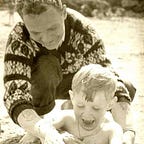THE FUTURE OF SODA IS BLUE — BUILDING A UV SPECTROPHOTOMETER
More explorations on how to engage students in Science — This is part of my ongoing experimentation on how to deliver chemistry topics to students in a more engaging and contextually relevant way.
In my Innovation in Chemistry class we read a piece from Fast Company Magazine called “ the Future of Soda is Blue “. The idea of me sourcing these articles is to surface new innovations in the chemical industry that might capture the student's interest. Capturing their interest in this topic often means that they are automatically inspired and curious to learn more about this area of chemistry.
I have sourced many articles on scientific innovations and inventions that can be accessed here.
The vivid blue color of a new brand of Dutch soda doesn’t come from food coloring: The startup making the product, called Ful, makes the drink with spirulina, a blue-green algae that gives the soda more of a nutritional punch than the standard carbonated beverage. (via Fast Company)
So I asked the students if they would want to analyze the soda to see what was in it.
They agreed.
I told them that the next thing we would do was to build a UV Spectrophotometer, this is the instrument we would need to do the analysis.
My colleague Tracy Rudzitis pointed me to Science Buddies .
At this site, we got instructions on how to proceed.
Even though we had all of the parts to build the UV Spectrophotometer in our IDEA LAB I decided to order the KIT anyway so we could build two spectrophotometers.
So we started to build the spectrophotometer out, everything is documented here on instagram
What is a UV Spectrophotometer?
A UV spectrophotometer is a scientific instrument that measures the amount of ultraviolet (UV) light absorbed by a substance. UV spectrophotometry is a powerful analytical technique that can be used to identify and quantify a wide variety of substances, including organic compounds, inorganic ions, and biological molecules.
UV spectrophotometers work by shining a beam of UV light through a sample. The amount of light that is absorbed by the sample is measured by a detector. The absorbance of the sample is then plotted as a function of wavelength. This plot, called a UV spectrum, can be used to identify the sample by comparing it to a library of known UV spectra.
UV spectrophotometry is a versatile technique that can be used in a wide variety of applications, including:
- Qualitative analysis: UV spectrophotometry can be used to identify the presence of a particular substance in a sample.
- Quantitative analysis: UV spectrophotometry can be used to determine the concentration of a particular substance in a sample.
- Structure determination: UV spectrophotometry can be used to determine the structure of organic compounds.
- Quality control: UV spectrophotometry can be used to ensure the quality of a product by measuring the concentration of a particular substance in the product.
- Environmental monitoring: UV spectrophotometry can be used to monitor the levels of pollutants in the environment.
UV spectrophotometry is a powerful analytical technique that has a wide range of applications. It is a valuable tool for scientists, engineers, and quality control professionals.
We built out many prototypes of the UV Spectrophotometer, take a look here .
We took measurements, and built the first few prototypes out on paper. We decided on the height of the spectrophotometer based on the cuvette height. The cuvette is a small device that we would be adding our solutions to to do the analysis. The size of the Spectrophotometer was also decided by what would be inside the instrument, which would be a battery, breadboard, LED, resistor, and some wires.
Schematic of the Science of a UV SPECTROPHOTOMETER
How do we get from the light absorbance of a dye sample to its concentration? This question is answered by the Beer-Lambert law.
A =εcl
- A = absorbance, which is unitless
- ε = molar absorption coefficient, measured in liters/(mol x cm).
- c = concentration, measured in moles per liter (mol/L).
- l = path length of the light through the sample, measured in centimeters (cm).
- Terms and concepts we covered:
- Food dye, Blue 1, Spectrophotometer, Wavelength, Nanometer (nm), Light absorption, Light transmission, Absorption spectrum, Light-emitting diode (LED), Photoresistor, Absorption filter, Wavelength selector, Resistance, ohms (Ω), Beer-Lambert law, Molar absorption coefficient, Breadboard, Standard solutions and Calibration curve.
An early prototype of our UV Spectrophotometer
Final Prototype of the bottom part of the case of UV Spectrophotometer
Final Prototype of cover case of UV Spectrophotometer
Cuvettes and test solutions
The next step was to calibrate the UV Spectrophotometer.
Measuring the different concentrations of blue dye
Measuring the different concentrations of blue dye
Measuring the different concentrations of blue dye
The next step will be to compare the UV Spectrophotometer we made to a commercially available UV Spectrophotometer.
Stay tuned for the results.
What I’m finding is when I let the students decide on the science content their level of engagement is increased. Since they are naturally curious about the topic it makes it easier for them to remain engaged. The students are driving the content and hence the learning and I’m just facilitating the experience.
